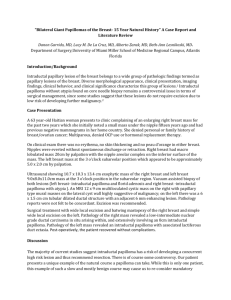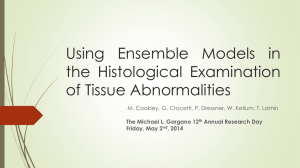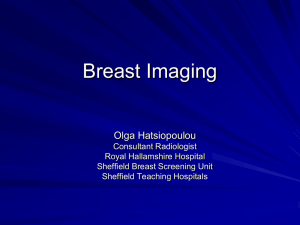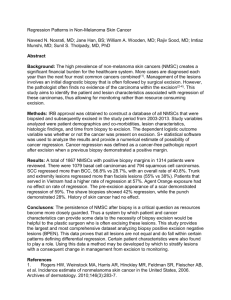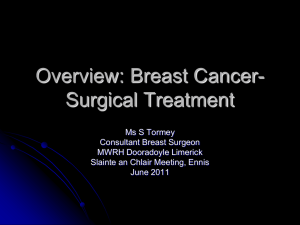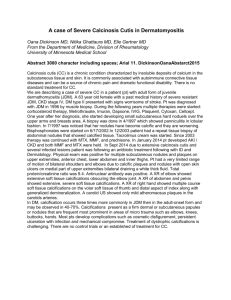Benign - Pathology
advertisement
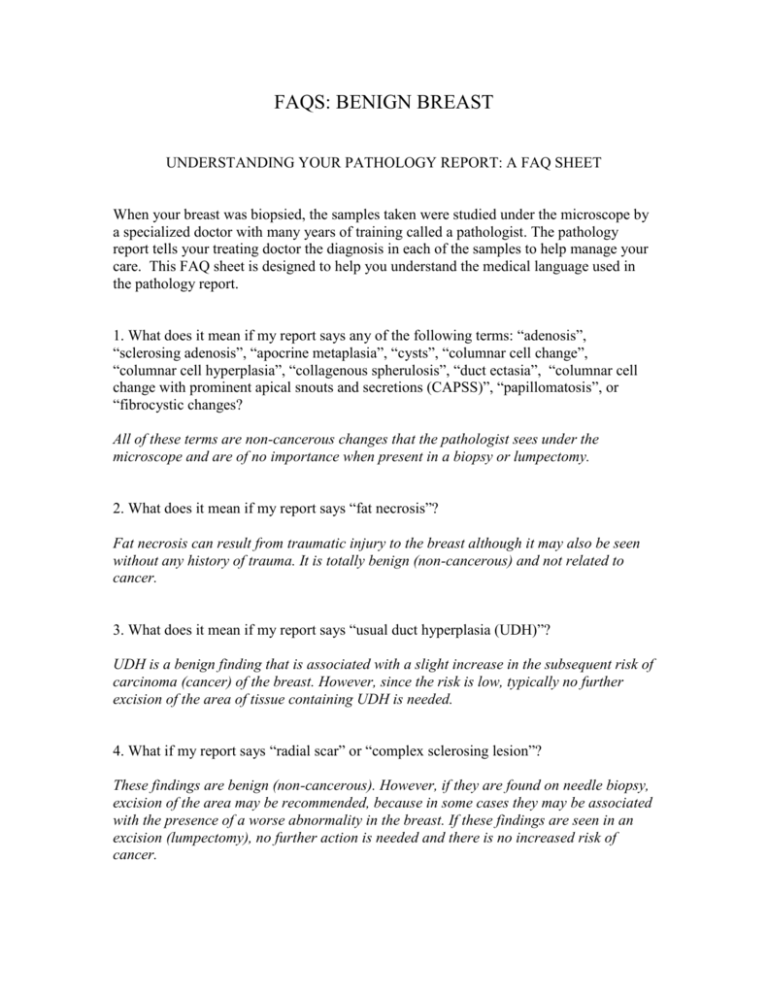
FAQS: BENIGN BREAST UNDERSTANDING YOUR PATHOLOGY REPORT: A FAQ SHEET When your breast was biopsied, the samples taken were studied under the microscope by a specialized doctor with many years of training called a pathologist. The pathology report tells your treating doctor the diagnosis in each of the samples to help manage your care. This FAQ sheet is designed to help you understand the medical language used in the pathology report. 1. What does it mean if my report says any of the following terms: “adenosis”, “sclerosing adenosis”, “apocrine metaplasia”, “cysts”, “columnar cell change”, “columnar cell hyperplasia”, “collagenous spherulosis”, “duct ectasia”, “columnar cell change with prominent apical snouts and secretions (CAPSS)”, “papillomatosis”, or “fibrocystic changes? All of these terms are non-cancerous changes that the pathologist sees under the microscope and are of no importance when present in a biopsy or lumpectomy. 2. What does it mean if my report says “fat necrosis”? Fat necrosis can result from traumatic injury to the breast although it may also be seen without any history of trauma. It is totally benign (non-cancerous) and not related to cancer. 3. What does it mean if my report says “usual duct hyperplasia (UDH)”? UDH is a benign finding that is associated with a slight increase in the subsequent risk of carcinoma (cancer) of the breast. However, since the risk is low, typically no further excision of the area of tissue containing UDH is needed. 4. What if my report says “radial scar” or “complex sclerosing lesion”? These findings are benign (non-cancerous). However, if they are found on needle biopsy, excision of the area may be recommended, because in some cases they may be associated with the presence of a worse abnormality in the breast. If these findings are seen in an excision (lumpectomy), no further action is needed and there is no increased risk of cancer. 5. What does it mean if my report says “papilloma”? A papilloma is a benign (non-cancerous) growth. When papilloma is diagnosed on needle biopsy, if the lesion is small and the mammogram findings are consistent with a papilloma, no further excision may be suggested. However, in many cases, an excision may be recommended to exclude the presence of a worse abnormality in the breast. The management of a papilloma on needle biopsy is best discussed with your treating physician. If papilloma is found on an excision (lumpectomy), typically no further treatment is needed. 6. What does it mean if my report says “flat epithelial atypia”? By itself, flat epithelial atypia is not cancer. However, since a minority of cases diagnosed on needle biopsy has a worse abnormality in the breast on subsequent excision, surgical excision is often recommended. If flat epithelial atypia is present on an excision (lumpectomy), then typically no further action is needed. However, this area is controversial and you should discuss this finding with your treating physician. 7. What if my report says “fibroadenoma”, “fibroepithelial lesion”, “phyllodes tumor”? Fibroadenoma is the most common benign (noncancerous) growth in the breast. If it is diagnosed on needle biopsy and the mammographic finding is consistent with a fibroadenoma, it is typically simply followed, with no additional excision. In some instances it may be removed for cosmetic reasons. Phyllodes tumor is a growth that, depending on the microscopic appearance may either have a risk of coming back (recurring) or a low risk of spreading beyond the breast (metastasizing). If a phyllodes tumor is diagnosed on needle biopsy, your treating physician will typically recommend complete removal of the growth. In some cases on needle biopsy it may be difficult for a pathologist to determine whether the growth is a fibroadenoma or phyllodes tumor and terms such as “cellular fibroepithelial lesion” may be used. In these cases, subsequent complete removal is typically recommended. 8. What does it mean if my report mentions “microcalcifications” or “calcifications”? “Microcalcifications” or “calcifications” are minerals that are found in both noncancerous and cancerous breast lesions and can be seen both on mammograms and under the microscope. Because some calcifications are associated with cancerous lesions, their presence on a mammogram may lead to a biopsy of the area. When they are seen by the pathologist in a biopsy specimen which was obtained because of a mammographic abnormality with calcifications, their presence is included in the pathology report to let the treating physician know that the abnormal area with calcifications seen in the mammogram was successfully sampled. Without accompanying worrisome changes in the breast ducts or lobules, “microcalcifications” or “calcifications” alone have no significance. 9. What does it mean if my biopsy report mentions special studies such as high molecular weight cytokeratin (HMWCK), CK903, CK5/6, p63, muscle specific actin, smooth muscle myosin heavy chain, or calponin? These are special tests that the pathologist sometimes uses to help make the correct diagnosis of a variety of breast lesions. Not all cases need these special tests. Whether your report does or does not mention these tests has no bearing on the accuracy of your diagnosis.

